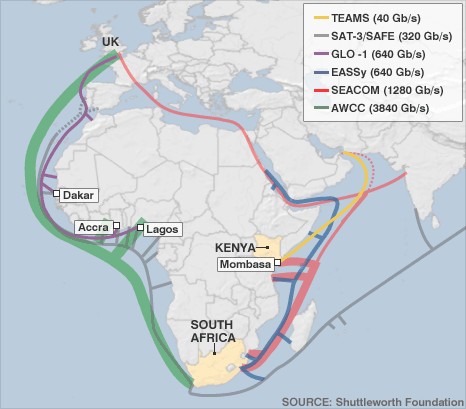FCC Chairman Julius Genachowski recorded a YouTube video to talk to Americans about the development of a national broadband plan for the United States.
In optimistic, flowery language, Genachowski invited Americans to submit their ideas and suggestions not only regarding broadband, but also the priorities Americans think the FCC should have in the future.
The most important part of the five minute video comes right in the beginning when Genachowski called broadband critical to the nation:
“Broadband is our generation’s major infrastructure challenge. It’s for us what railroads, highways and electricity were to past generations.”
<
p style=”text-align: center;”>
Genachowski would do well to remember America’s experience with all three of these important history lessons. The broadband plan Genachowski envisions is subject to the same type of intrusive, anti-consumer tactics that wreaked havoc on past generations of consumers.
The railroad industry’s cartel of ownership and control is a familiar tale. The Rise of Monopolies tells the story:
The need for all of these industries to stay successful was worrisome for railroad owners. To avoid the loss of production in any of these areas, large corporations attempted to stabilize their situations by pooling markets and centralizing management. By combining all of the fields into one conglomeration, the railroads had a new power, as they acquired control of many facets of the new economy. This body now had the ability to “squeeze out competitors, force down prices paid for labor and raw materials, charge customers more and get special favors and treatments from National and State government” (Chalmers). The railroads had all the power, because they controlled all the prices. Since the new residents of the West could not survive without the use of the railroads, they were forced to pay whatever rates the railroad companies set.
With these huge stores of capital, the railroad companies were able to finance political campaigns through whatever and whomever was needed in government. With this control in Washington, there was no way to stop the overwhelming control of this industry over society. The entire nation was subject to the whims of this monopoly.
It took direct government intervention to break up the railroad monopoly and protect consumers and businesses from the abusive practices of a transportation industry that can make or break you based on pricing and service, with little competition.
Public highways became an important asset that still pays off today. The Eisenhower Administration’s deployment of the interstate highway system, at the size and scope required, would not have been accomplished by the private sector on its own. Today’s federal highway system is largely self sustaining through the collection of gasoline taxes paid by drivers.
As Americans struggle with several incumbent providers that refuse to provide 21st century broadband technology, with little competition to drive that infrastructure investment, an uneven variety of broadband networks have emerged, from fiber to the home in some areas to an indefinite reliance on aging DSL slow speed technology for millions of rural Americans, or worse, inadequate satellite broadband.
It may be time to consider the same kind of national approach with a publicly owned fiber network private providers of all kinds can use to serve customers with a uniformly high speed, high quality user experience.
Electricity and the development of rural America is another very familiar tale to any rural broadband user. From TVA: Electricity for All:
Although nearly 90 percent of urban dwellers had electricity by the 1930s, only ten percent of rural dwellers did. Private utility companies, who supplied electric power to most of the nation’s consumers, argued that it was too expensive to string electric lines to isolated rural farmsteads. Anyway, they said, most farmers, were too poor to be able to afford electricity.
The Roosevelt Administration believed that if private enterprise could not supply electric power to the people, then it was the duty of the government to do so. Most of the court cases involving TVA during the 1930s concerned the government’s involvement in the public utilities industry.
In 1935 the Rural Electric Administration (REA) was created to bring electricity to rural areas like the Tennessee Valley.
Many groups opposed the federal government’s involvement in developing and distributing electric power, especially utility companies, who believed that the government was unfairly competing with private enterprise. Some members of Congress who didn’t think the government should interfere with the economy, believed that TVA was a dangerous program that would bring the nation a step closer to socialism. Other people thought that farmers simply did not have the skills needed to manage local electric companies.
Any community wrestling with a municipal broadband project to provide service the private market refused to offer is already acquainted with this familiar story. So are many rural consumers who are waiting, and waiting, and waiting, for the private market to bring broadband to their communities. Unfortunately for them, the private market has already written them off as “not profitable enough” to provide service.
The electrification of America did not lead to a socialist takeover of America. It led to the development and sustainability of rural communities and their local economies. Agriculture remains one of America’s most important success stories, and without widespread electrification, this story might not have been written.
Scare tactics and horror stories have come whenever a private monopoly or cartel faces the threat of competition, regulation, or a municipal option to provide needed services communities are denied by the private sector.
The fear mongering was there when the railroad monopolies faced investigation and regulation, the “socialism” scare was heard when government attempted to undertake public infrastructure projects of many kinds from highways to utility service, and the same kinds of rhetoric is heard today about “socialist takeovers of the Internet” and “municipal broadband unfairly competes with private providers,” and the logical opposite “the government can’t do anything right.”
Unfortunately, the FCC has a long history of cozy relations with lobbyists who understand how to work within the agency’s nearly-impenetrable bureaucracy. A review of the broadband plan submissions to the FCC reveals a large number of them come from lobbying groups and the providers themselves. Most consumers were left typing comments into a box on the web submission form, with every indication those remarks will be deemed “not serious” by FCC staff.
This time, Chairman Genachowski has to show more than a YouTube video inviting consumers to share their input. We’d like actual evidence the consumer point of view is actually being taken seriously for a change, and is not simply one tiny noise drowned out in a loud crowd of special interests with profit agendas to protect and public policy to influence. The FCC already knows what consumers want: widely available, fast, reasonably priced broadband free from Internet Overcharging schemes protected with robust Net Neutrality policies enforced by law.
If the existing providers want to erect roadblocks to competition, oversight, and hell-or-high-water-broadband-deployment, it’s time to break them up and get them out of the way. That’s broadband we can believe in.


 Subscribe
Subscribe



